The Aesir god Heimdall is the guardian of the Bifröst, the rainbow bridge connecting Asgard to the other realms. Heimdall is the son of Odin and no less than nine mothers, giving him a pretty unique origins story. He is prophesied to blow in his horn Gjallarhorn, on the day the jotnar attack at Ragnarök.
In this article I am trying to present a bit more facts about who Heimdall actually is in Norse mytholgy. There are several theories about him that can’t all be true. However, I feel some scholars like to discuss the possibilities so much it actually gets in the way of what we can say we know. This is part of what I personally find so interesting with Norse mythology, there are lots of known facts, but some things you have to choose yourself.
Heimdall Key Facts
| Parents | Odin and Nine mothers (likely daughters of Ran and Aegir) |
| Partners | None known |
| Siblings | Half-brother to Odin’s other children |
| Offspring | None known (Indirectly, all of mankind) |
| Tribe | Aesir |
| Old Norse name | Heimdallr |
| Other names | Rig, Hallinskiði, Gullintanni |
| The God of | Watchfulness, Light, and Loyalty |
| Ass. Animal | Ram (due to his horn, Gjallarhorn) |
Name and Etymology
Heimdall’s name in Old Norse, “Heimdallr”, is believed to be derived from the words “heim” and “dallr”, which mean “world” and “resounding” respectively. This could allude to his role as the guardian of the Bifröst, echoing the sounds of the world. The god also goes by other names, each carrying its own significance and story.
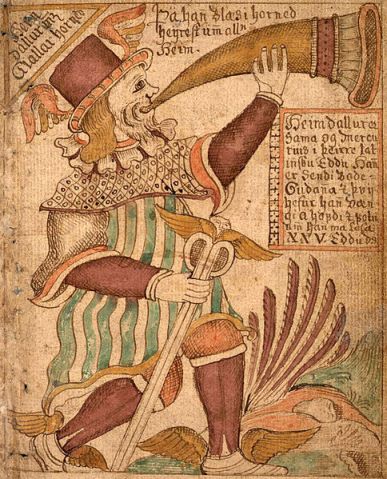
For instance, “Rig” is another name associated with Heimdall. In the Rigsthula, a part of the Poetic Edda, Heimdall (as Rig) fathers the ancestors of the three societal classes in the Norse world, symbolizing the creation of societal hierarchy. The name “Rig” itself might be derived from the Old Norse word for “king” or “ruler”. I want to add though, that there are those that argue that think Rig was actually Odin, and the Heimdall has been mistaken as Rig.
“Hallinskiði” is yet another epithet for Heimdall. The term can be broken down into “hallr”, meaning “rock” or “stone”, and “skiði”, which translates to “beam” or “ram”. This could be a reference to his steadfast nature, much like the unwavering quality of a rock, and his association with the ram due to his Gjallarhorn.
“Vindlér” or “Vindhlér” is another moniker for Heimdall. The name suggests a connection to the winds (“vind” in Old Norse) and possibly the sea. Given Heimdall’s birth from (most likely) the nine daughters of the sea god Aegir, this name might emphasize his deep ties to the sea and its ever-changing, windy nature.
Lastly, “Gullintanni” translates to “gold-toothed”, emphasizing his radiant and illuminating nature. His golden teeth are not just a physical characteristic but also symbolize his association with light and possibly his ability to shine wisdom or clarity in murky situations.
Pre-Viking Age Roots
Heimdall’s name is deeply rooted in Norse mythology. However, traces of similar figures can be found in older Germanic myths. Unlike other Norse gods, Heimdall doesn’t have direct counterparts in Roman or Gothic traditions. His unique position in Norse tales, combined with the lack of parallels in other mythologies, makes him a particularly intriguing figure.
Heimdall Origins
Heimdall was born to the Allfather Odin and, amazingly, nine mothers. It’s my strong belief that these Nine Mothers are the nine daughters of Aegir and Ran. I can’t really see that there would be another group of nine maidens (otherwise unheard of), being the collective mothers of a god. So moving on, this is my position and basis for the rest on his origins.
His nine mothers names are Angeyja, Atla, Eistla, Eyrgjafa, Gjolp, Greip, Imth, Järnsaxa, and Ulfrun. As daughters of the sea god Aegir and the sea goddess Ran, they personify the waves. Giving Heimdall a deep connection to the sea and its myriad mysteries.
Odin’s union with these nine wave sisters resulted in the birth of Heimdall, a god endowed with unparalleled senses and vigilance. As I already alluded to though, we know nothing about how and when this happened. Odin does have quite a few children with others than Frigg though so to me this seems quite likely.
The relationship between Heimdall and his parents is a testament to the interconnectedness of the gods in Norse myths. With Odin as his father, Heimdall is directly linked to the chief god, granting him a prominent position among the Aesir. Meanwhile, his maternal connection to Aegir, Ran, and the waves ties him to the vast and unpredictable nature of the sea. This duality in his lineage – of sky and sea – makes Heimdall a bridge between two elemental forces. This sort of lends itself to his role as the guardian of the Bifröst, the bridge between realms.
Heimdall’s Siblings
Heimdall’s siblings, each remarkable in their own right, all being sond of Odin. Baldur, the radiant and beloved; Bragi, the eloquent bard; Hodr, the blind god of winter; Thor, the thunderous protector; Tyr, the brave god of war; Vali, the avenger born of purpose; and Vidarr, the silent and steadfast. Together, they form a formidable assembly of deities, each contributing to the rich tapestry of Norse myths.
Heimdall Family and Relationships
Heimdall’s relationships, unlike those of other gods, aren’t highlighted prominently in the myths. While many gods had numerous affairs and offspring, Heimdall’s tales focus more on his duties than personal relationships. Having said this, I think it is possible Heimdall had both a wife and children, but that we have lost this knowledge.
Children
There aren’t specific myths detailing Heimdall’s children. However, he is sometimes associated with the triad of societal classes in the Norse world: thralls (serfs), karls (freemen), and jarls (nobility). In the Rigsthula, Heimdall, under the name Rig, fathers the ancestors of these three classes, symbolizing the creation of societal hierarchy.
Heimdall Roles And Responsibilities
Heimdall’s primary responsibility, and perhaps his most iconic, is as the guardian of the Bifröst. This rainbow bridge, connecting Midgard (the realm of humans) to Asgard (the realm of the gods), is a vital passage. Heimdall’s role in its protection is paramount. His unwavering vigilance is legendary; it’s said that he never sleeps, a testament to his dedication to his duty. His senses, sharpened beyond comprehension, allow him to hear the softest sounds, such as wool growing on a sheep. His eyesight, too, is unparalleled; he can discern the tiniest of objects from hundreds of miles away, ensuring that no threat goes unnoticed.
Beyond his guardianship, Heimdall is also believed to have played a significant role in the creation of humanity’s societal classes. In the Rigsthula, a part of the Poetic Edda, Heimdall, under the name Rig, is said to have fathered the ancestors of the three societal classes in the Norse world: thralls (serfs), karls (freemen), and jarls (nobility). This narrative paints him as a foundational figure in the establishment of societal hierarchy.
However, like I already touched upon, there’s a twist to this tale. Some scholars believe that it might have been Odin, not Heimdall, who fathered these classes. The attribution of this act to Heimdall could be based on a misunderstanding or misinterpretation by these scholars.
Regardless of this debate, I think Heimdall’s significance in Norse mythology is undeniable. Whether it’s his role as the ever-watchful guardian or his potential influence on human society, Heimdall stands as a figure of unwavering duty, acute perception, and profound impact.
Depiction And Characteristics
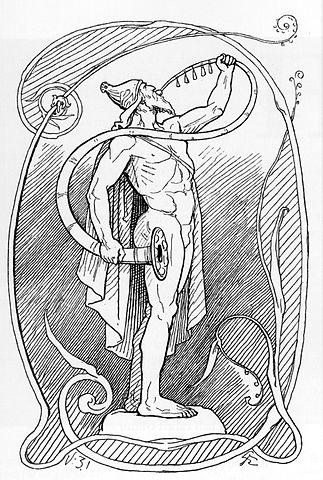
Heimdall is often depicted as a strong, radiant figure, standing tall with his Gjallarhorn. His golden teeth and bright appearance signify his association with light. In the myths, he’s portrayed as a loyal and steadfast god, always ready to defend Asgard. His attire, usually consisting of armor, further accentuates his role as the realm’s guardian.
His dwelling, known as Himinbjörg (which translates to “Sky Cliffs” or “Heaven’s Castle”), is situated right at the entrance of the Bifröst bridge. This strategic location allowed him to keep a watchful eye on any approaching entities, ensuring the safety of Asgard. Himinbjörg wasn’t just his home; it was his fortress, his watchtower, from where he could survey all realms.
Beyond his physical attributes and residence, Heimdall’s character is defined by his unwavering dedication to his duty. While other gods often indulged in mischief and personal pursuits, Heimdall remained committed to his role, showcasing his unparalleled integrity. Moreover, his unique birth and the mystery surrounding his origins add an aura of enigma to his character, making him one of the most intriguing gods in Norse mythology.
Heimdall Artifacts or Animals
The most iconic artifact associated with Heimdall is the Gjallarhorn. This horn, when blown, produces a sound that resonates across all the realms. It’s believed that the Gjallarhorn will be blown at the onset of Ragnarok, signaling the beginning of the end. The horn’s deep, resonating sound is symbolic of Heimdall’s role as the herald of the gods, alerting them to impending danger.
Heimdall is also known to wield a powerful sword named Hǫfuð, which translates to “man-head” or simply “Head”. This sword, mentioned in the Gylfaginning and Skáldskaparmál, carries with it a sense of mystery. The Skáldskaparmál alludes to an enigmatic myth involving Heimdall’s head and his sword, though the details of this tale remain elusive in the surviving texts.
Another significant symbol associated with Heimdall is his golden-maned horse, Gulltoppr. In Norse mythology, many gods have their unique steeds, and Gulltoppr is Heimdall’s loyal companion. The horse’s name translates to “Golden Mane”, and it’s believed to be one of the fastest and most majestic creatures in all the realms. Gulltoppr’s brilliance and speed mirror Heimdall’s own qualities of radiance and alertness.
His association with rams is primarily due to his horn, which is reminiscent of a ram’s curled horns. This connection further emphasizes his protective nature, as rams are often seen as symbols of guardianship and defense.
Additionally, his golden teeth are not just a physical characteristic but also symbolize his radiant and illuminating nature, reinforcing his association with light. Together, the Gjallarhorn, Gulltoppr, Hǫfuð, and his golden teeth paint a vivid picture of a god who is ever-watchful, shining brightly as the sentinel of the gods.
Play Fun Norse Quiz
Is this article making you even more curious about Norse gods and goddesses? You can satisfy your curiosity by playing a fun Norse mythology quiz. This way, you can test your knowledge about Norse gods and goddesses, as well as fill in some gaps. Good luck and have fun playing!
You might be interested in this fun game too! It reveals the parentage of Heimdall and other sons (and daughters) of Odin:
Don’t forget to try our other games as well!
Myths about Heimdall
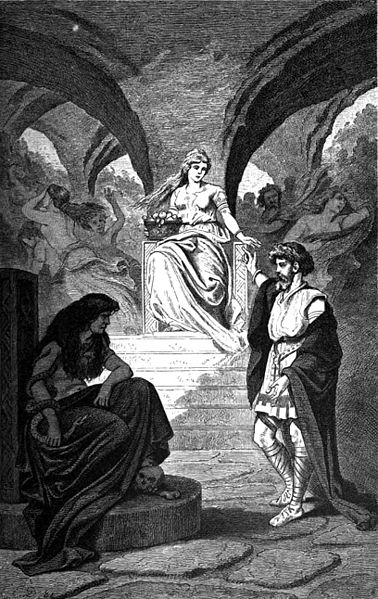
Heimdall’s tales, though not as numerous as some other Norse gods, are rich in detail and significance. They often highlight his role as the guardian of Asgard, his keen senses, and his interactions with other gods and beings.
Heimdall and Loki’s Duel at Singasteinn
The tension between Heimdall and Loki culminates in a fierce duel over the Brisingamen, the beautiful necklace of the goddess Freyja. Loki, ever the trickster, manages to steal this precious artifact. However, Heimdall’s keen senses allow him to track down Loki. Their confrontation takes place at Singasteinn, a legendary location often associated with significant events in Norse mythology. In the ensuing battle, Heimdall emerges victorious, retrieving the Brisingamen and ensuring it’s returned to Freyja. This tale not only underscores Heimdall’s dedication to justice and order but also solidifies the enmity between him and Loki, setting the stage for their final confrontation in Ragnarok.
Rigsthula: Heimdall as the Ancestor of Mankind
In the Rigsthula, Heimdall assumes the identity of Rig, traversing the land and interacting with its inhabitants. He visits three households, each symbolizing a distinct societal class in Norse culture. At the home of the thralls, he imparts lessons of servitude and hard work. With the karls, he discusses the values of freemen, emphasizing independence and self-reliance. Finally, with the jarls, he delves into the responsibilities of nobility and leadership. These visits result in the birth of the ancestors of the three classes, laying the foundation for Norse societal structure. Through this myth, Heimdall’s influence on human civilization is highlighted, showcasing his role not just as a guardian of gods but also as a guide for mankind.
Heimdall’s Role in Ragnarok
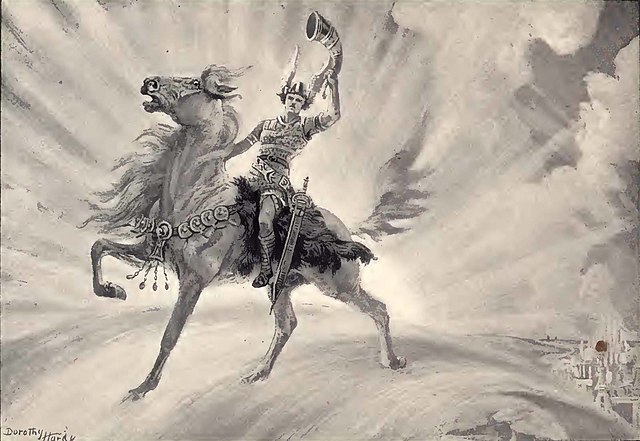
Ragnarok, the prophesied end of the world, sees Heimdall in a crucial role. As the forces of chaos, led by the Jötnar, march on the Bifröst bridge, Heimdall stands ready. With the Gjallarhorn in hand, he sounds the alarm, alerting the gods of the impending invasion. The final battle is not just a clash of armies but a confrontation of cosmic principles. Heimdall and Loki, representing order and chaos respectively, face off in a duel that has been brewing since the dawn of time. While the specifics of their duel remain shrouded in mystery, it’s believed that they will deliver fatal blows to each other, marking the end of their tales and the beginning of a new cosmic cycle.
These ancient texts provide a rich tapestry of tales and attributes associated with Heimdall, painting a vivid picture of his role and significance in Norse mythology.
Thrymskvida: Heimdall’s Cunning Plan
In the Thrymskvida, when Thor’s hammer Mjölnir is stolen by the giant Thrym, it’s Heimdall who comes up with the ingenious plan to retrieve it. He suggests that Thor disguise himself as Freyja to be offered as a bride to Thrym, with the intent of reclaiming the hammer during the wedding festivities. This tale showcases another facet of Heimdall’s character – his wisdom and strategic thinking. While he is often seen as the vigilant guardian, this myth highlights his ability to devise cunning plans to outwit adversaries.
Mentions in Ancient Texts
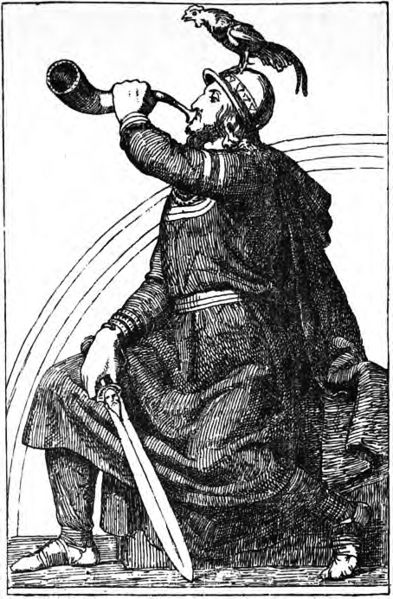
Heimdall, often shimmering in the background of Norse myths, stands as a testament to the intricate tapestry of ancient tales. While he may not always take center stage, his frequent attestations across a myriad of sagas and poems underscore his significance in the pantheon. This omnipresent guardian, with his keen senses and vigilant watch over Bifröst, is woven deeply into the fabric of Norse mythology, highlighting his central role even when he’s not the protagonist of the tale.
From the Poetic Edda:
Völuspá:
Heimdall is mentioned thrice in Völuspá. The undead völva, who recites the poem, beckons for silence and refers to him:
“Hearing I ask from the holy races,
From Heimdall’s sons, both high and low;
Thou wilt, Valfather, that well I relate.
Old tales I remember of men long ago.” – Henry Adams Bellows translation.
This stanza has sparked various interpretations, with some scholars suggesting that humanity might be referred to as “Heimdall’s sons”. Another significant mention in Völuspá is when Heimdall blows his Gjallarhorn, signaling the onset of Ragnarök:
“Fast move the sons of Mim and fate
Is heard in the note of the Gjallarhorn;
Loud blows Heimdall, the horn is aloft,
In fear quake all who on Hel-roads are.” – Henry Adams Bellows translation.
Grímnismál:
In Grímnismál, Odin describes various mythological places, including Himinbjörg, where Heimdall is said to drink fine mead:
“Himingbjorg is the eighth, and Heimdall there
O’er men holds sway, it is said;
In his well-built house does the warder of heaven
The good mead gladly drink.” – Henry Adams Bellows translation.
Other Poems:
Heimdall also appears in Lokasenna, Þrymskviða, Rígsþula, and Hrafnagaldr Óðins, each offering different facets of his character and his interactions with other deities.
From the Prose Edda:
Gylfaginning:
In Gylfaginning, Heimdall is described as the “white As”, “great and holy”, and the son of nine maidens. He lives in Himinbjörg, near Bifröst, and serves as the gods’ watchman. His keen senses allow him to both see and hear over vast distances. His trumpet, Gjallarhorn, will sound the onset of Ragnarök.
Skáldskaparmál:
In Skáldskaparmál, Heimdall’s various names and attributes are detailed. He is referred to as the “son of nine mothers”, the “guardian of the gods”, and the “white As”. His rivalry with Loki over the Brísingamen necklace is also recounted, with the two transforming into seals during their struggle.
Háttatal:
In Háttatal, a sword is poetically referred to as “Vindhlér’s helmet-filler”, meaning “Heimdall’s head”.
From Heimskringla:
In Ynglinga saga, part of Heimskringla, the gods are presented in a euhemerized form. Heimdall is said to dwell at Himinbjörg, and, like other gods, he is given an estate in what is now Sweden.
The Lost Heimdalargaldr
Two places in the Prose Edda, you can find references made to a poem called Heimdalargaldr. Sadly, this old poem has been lost, and very little of it remains. In Gylfasginning there is a short quote from it where Heimdall says he is the son of nine mothers.
This is hardly unique in the world of Norse mythology, where I think many poems and sagas have been lost. My understanding is that Christians in the Early Medieval times led a charge to burn all “heathen” books, which accounts for much of this loss. I think that poem would likely have given us a much better understanding of Heimdall and his origins. Moreover, I think it’s likely that there were similar works about other gods, like Ullr and Týr, that were also lost. That is just what we are left with though, so I would caution anyone against making bombastic claims or arguments. Some things we will never know.
Frequently Asked Questions
Heimdall is both the guardian of the Bifröst, and wathcman of the gods. Responsible for protecting Asgard from threats.
He was born to nine mothers, believed to be the daughters of the sea god Aegir.
It’s a horn that Heimdall will blow to signal the onset of Ragnarok.
He is often portrayed as a radiant figure with golden teeth, symbolizing light and vigilance.
In the Rigsthula, under the name Rig, he fathers the ancestors of the three societal classes in the Norse world.
He will face his adversary, Loki, in battle, and both are destined to perish.
